Edgar Degas – The Impressionist Works of Degas
The Impressionist artist, Edgar Degas, was renowned for his paintings, sculptures, prints, and sketches. The French painter Degas did not actually think of himself as an Impressionist, but rather as a Realist artist. Degas’ dancers are particularly renowned, as more than half of his artworks feature them. This article will explore French painter Edgar Degas’ biography, as well as the history behind Edgar Degas’ paintings.
Contents
Edgar Degas’ Biography
| Full Name | Hilaire-Germain-Edgar De Gas |
| Nationality | French |
| Date of Birth | 19 July 1834 |
| Date of Death | 27 September 1917 |
| Place of Birth | Paris, France |
Although the French painter Edgar Degas’ paintings are often the most discussed element of his oeuvre, Degas’ sculptures were another notable part of his overall work, as well as his drawings and prints. While Degas the artist was often labeled an Impressionist, he did not paint outdoors as traditional Impressionists did. Besides Degas’ ballerina paintings, he also liked to produce portraits, as well as paintings of racehorses and jockeys.
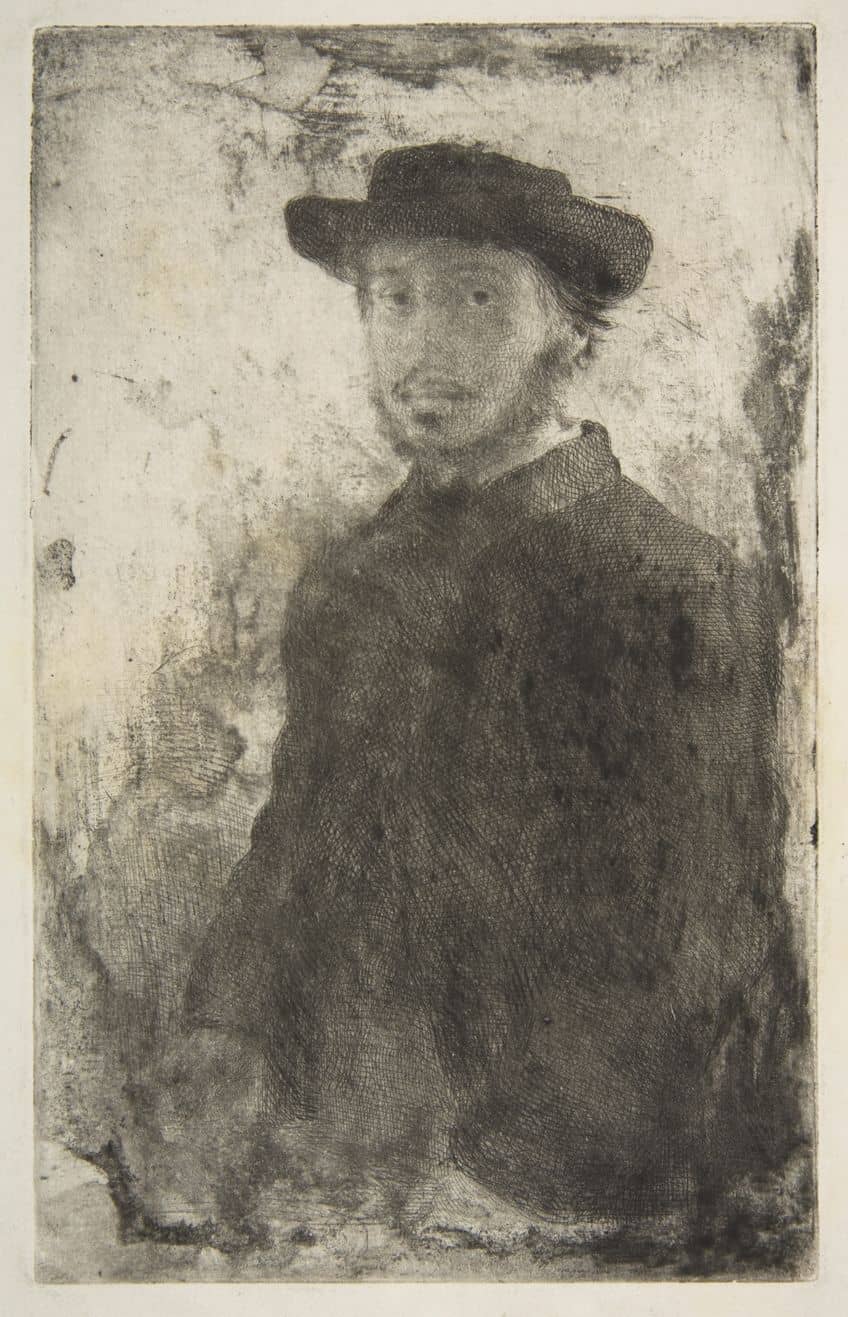
Degas’ portraits were particularly noted for their portrayal of psychological complexity and isolation. Due to his studies of classical art and academic training, he initially wanted to be a history painter, but in his 30s he decided that he would prefer to portray more contemporaneous subject matter. This led to him becoming a classic artist that portrayed modern life – a unique and captivating style that would ensure his popularity with many people.
Early Life
Degas was born into a reasonably well-off family in Paris, France. At the age of 11, Degas enrolled at the Lycée Louis-le-Grand to start his formal schooling. His father and many unmarried uncles were the predominant influences on him for the rest of his childhood when his mother passed away when he was 13 years of age. Degas started painting at a relatively young age. He had transformed a room in his house into a studio by the time he finished his studies at Lycée in 1853, at the age of 18.
He enlisted as a copyist at the Louvre Museum after graduation, however, his father wanted him to study at a law school.
In 1853, he enrolled in the University of Paris’ Faculty of Law, although he put very little effort into his studies. He then met Jean-Auguste-Dominique Ingres, whom he greatly admired, in 1855. Edgar Degas was then accepted to the École des Beaux-Arts in April of that year. He studied drawing there under Louis Lamothe, under whose instruction he excelled in the Ingres manner.

Degas moved to Italy in July 1856, where he spent the following three years. While residing with his aunt in Naples in 1858, he started working on one of his earliest masterworks, The Bellelli Family (1858 – 1867). He also sketched and painted many replicas of paintings by Raphael, Titian, Michelangelo, and other Renaissance painters, but, contrary to the traditional manner, he typically chose a feature from an altarpiece that attracted his eye: a minor figure or a head that he then portrayed as a portrait.
Early Training
When Degas returned to France in 1859, he moved into a studio in Paris large enough for him to continue painting The Bellelli Family, the huge canvas he planned to display in the Salon, but which remained incomplete until 1867. Edgar Degas visited his school friend Paul Valpinçon in Normandy in 1861 and created the first of many horse studies. He first exhibited at the Salon in 1865, when the jury approved his artwork Scene of War in the Middle Ages (1865), which received little recognition from the audience.
Despite exhibiting regularly in the Salon for the next five years, he did not enter any more historical works, reflecting his developing commitment to a more contemporaneous subject matter.
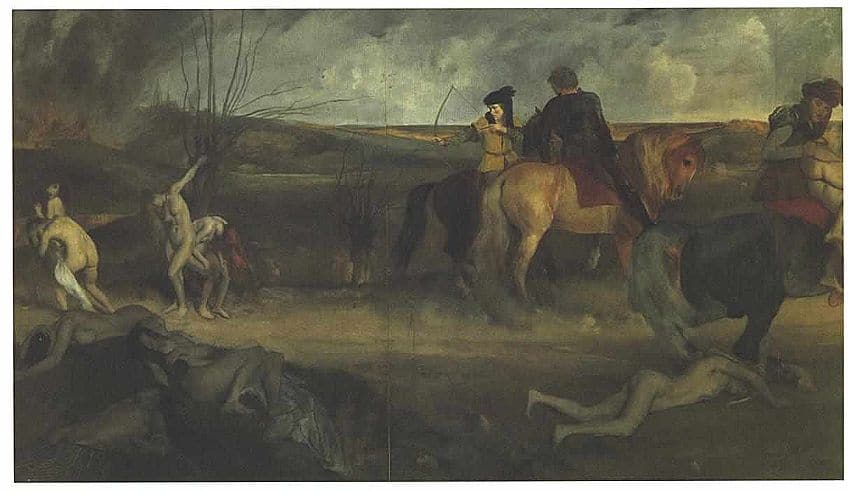
The influence of Édouard Manet, whom Degas had met in 1864 when both were reproducing the same Velázquez painting in the Louvre Museum, inspired the shift in his work the most. In 1870, Edgar Degas enlisted in the National Guard following the start of the Franco-Prussian War, leaving him with no time to produce art. It was discovered that he had eye problems during a rifle training session – something that would plague him his entire life and serve as a constant source of worry for the artist.
Mature Period
Following the war, French painter Degas undertook an extended sojourn in New Orleans in 1872, where he stayed with his brother René and several other relatives. Edgar Degas created a series of paintings while staying at his uncle’s house, Michel Musson, many of which depicted family members. A Cotton Office in New Orleans (1873), one of Edgar Degas’ paintings produced in that time period, received great acclaim in France and was his only piece bought by a museum during his lifetime. In 1873, Degas traveled to Paris and when his father died the following year, he discovered that his brother René had accumulated massive debts.
To restore his family’s name, Degas sold his apartment as well as an inherited art collection and used the profits to settle his brother’s debts.
For the first time in his entire life, he was financially dependent on the sale of his paintings, and he created most of his best work during the decade starting in 1874. Disillusioned with the Salon by this point, he joined a group of young painters who were forming an alternative exhibition society. This group was subsequently referred to as the Impressionists. Despite continuous conflicts with other members of the group, Edgar Degas took charge of organizing the exhibits and displayed his works in all but one of them.
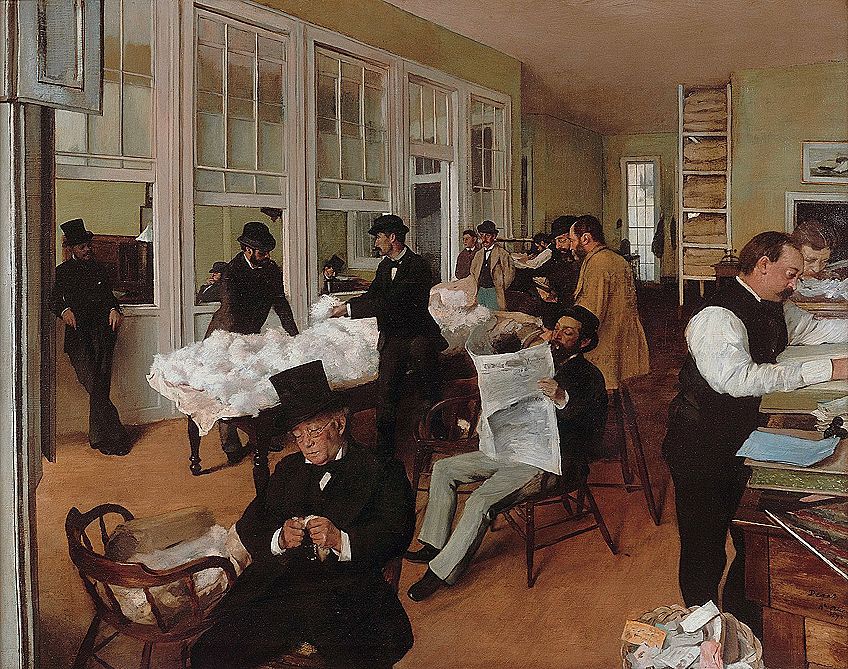
In reality, he shared little in common with Claude Monet and the other landscape artists in the collective, whom he often ridiculed for painting outside. He was socially conservative and detested the controversy caused by the exhibits, as well as the exposure and promotion that his colleagues desired. He also detested being branded with the label “Impressionist”, which the media had developed and promoted, and insisted on incorporating non-Impressionist painters in the group’s exhibits, such as Jean-François Raffalli and Jean-Louis Forain. The following internal disputes resulted in the group’s dissolution in 1886.
As his financial status improved as a result of the sales of his own works, he was able to satisfy his taste for collecting pieces by painters he respected, including El Greco and contemporary artists such as Cassatt, Manet, Édouard Brandon, Cézanne, Pissarro, Gauguin, and Van Gogh. Three of his favorite painters, Delacroix, Ingres, and Daumier, featured prominently in his collection.
Late Period
Degas grew fascinated by photography in the late 1880s. Many of his acquaintances were photographed by him, usually by lamplight, as in his double portraiture of Mallarmé and Renoir. Other photos of dancers and nude bodies were utilized as references in several of Edgar Degas’ paintings and sketches. Degas became increasingly isolated over the years, primarily due to his conviction that an artist should not have a personal life.
His controversial views on Jewish people would ultimately lead to him breaking ties with all of his Jewish friends.
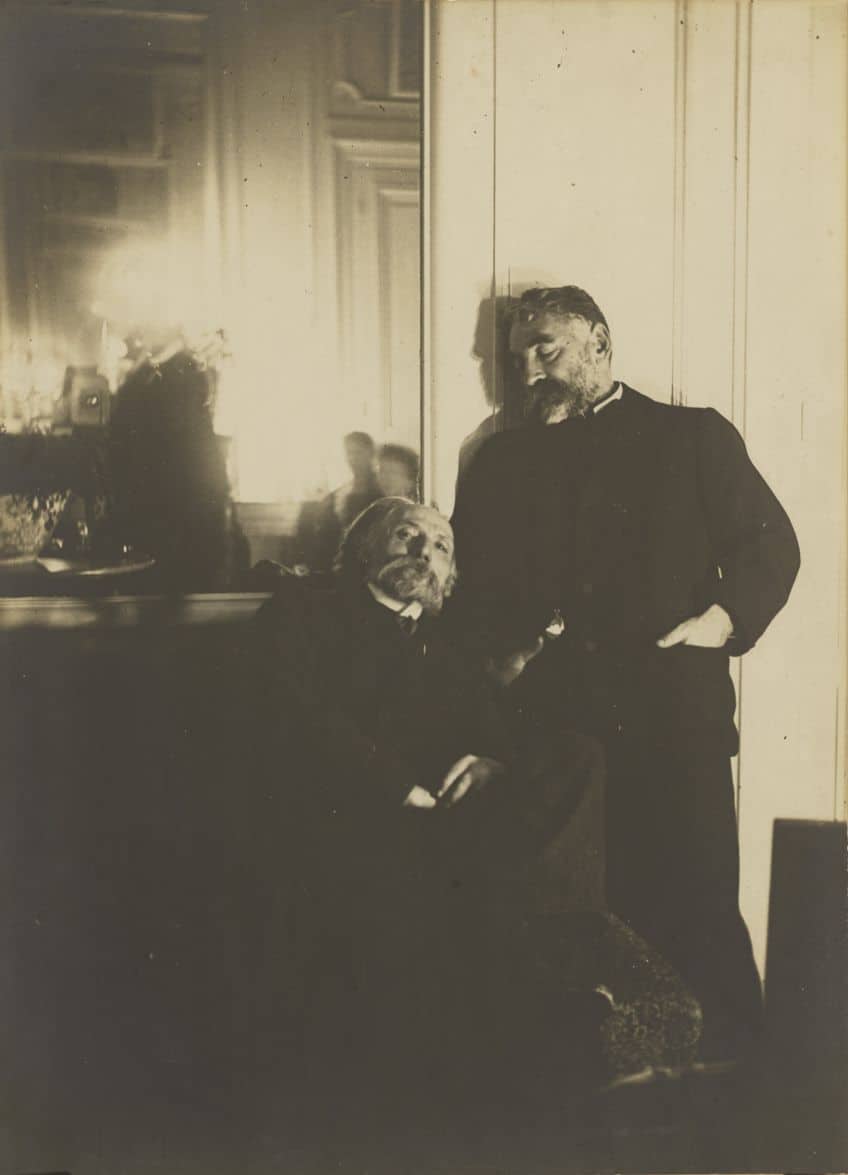
Even Renoir, who was one of the last people to stand by his side, was said to have eventually had enough of his argumentative nature, and too ended their friendship. His eyesight grew progressively worse, and although Degas’ sculptures were still being produced in 1910, by 1912, he had ceased making art completely. Due to his beliefs about creative isolation, he never married, and the last years of his life were spent wandering the Parisian streets, half-blind, eventually passing away in September 1917.
The Art Style of Degas the Artist
Degas is often labeled as an Impressionist, which is a sensible but inadequate definition. Impressionism emerged in the 1860s and 1870s, influenced by the realism of artists such as Corot and Courbet. The Impressionists employed brilliant, vivid colors to depict their surroundings realistically, focusing particularly on the effects of light and attempting to infuse their settings with a sense of vitality, hoping to express a specific moment as experienced visually. However, Degas was openly contemptuous of the practice of painting outdoors and was often outright anti-Impressionist in his views. Yet, his off-center compositions, depictions of Parisian life, explorations with form and color, and acquaintance with multiple key Impressionist painters, most particularly Manet and Mary Cassatt, all connect him to the Impressionist movement.
Degas’s style reveals his profound admiration for the old masters, particularly Delacroix and Ingres.
Themes in Edgar Degas’ Paintings
Degas was also a keen collector of Japanese prints, and the compositional techniques of prominent illustrators such as Gavarni and Daumier were also known to have had an impact on his works. While today, Degas’ dancers and horses are among his most well-known subjects, he originally started with traditional historical works in which his slow progression toward a less idealized portrayal of the figure was already starting to emerge. Degas was also intrigued by the conflicts that existed between the sexes. Degas’ early works revealed the mature style that he would later completely develop by cropping subjects unnaturally and employing unconventional points of view. Degas had moved on from his early forays into the genre of historical paintings by the late 1860s to a unique view of modern life.
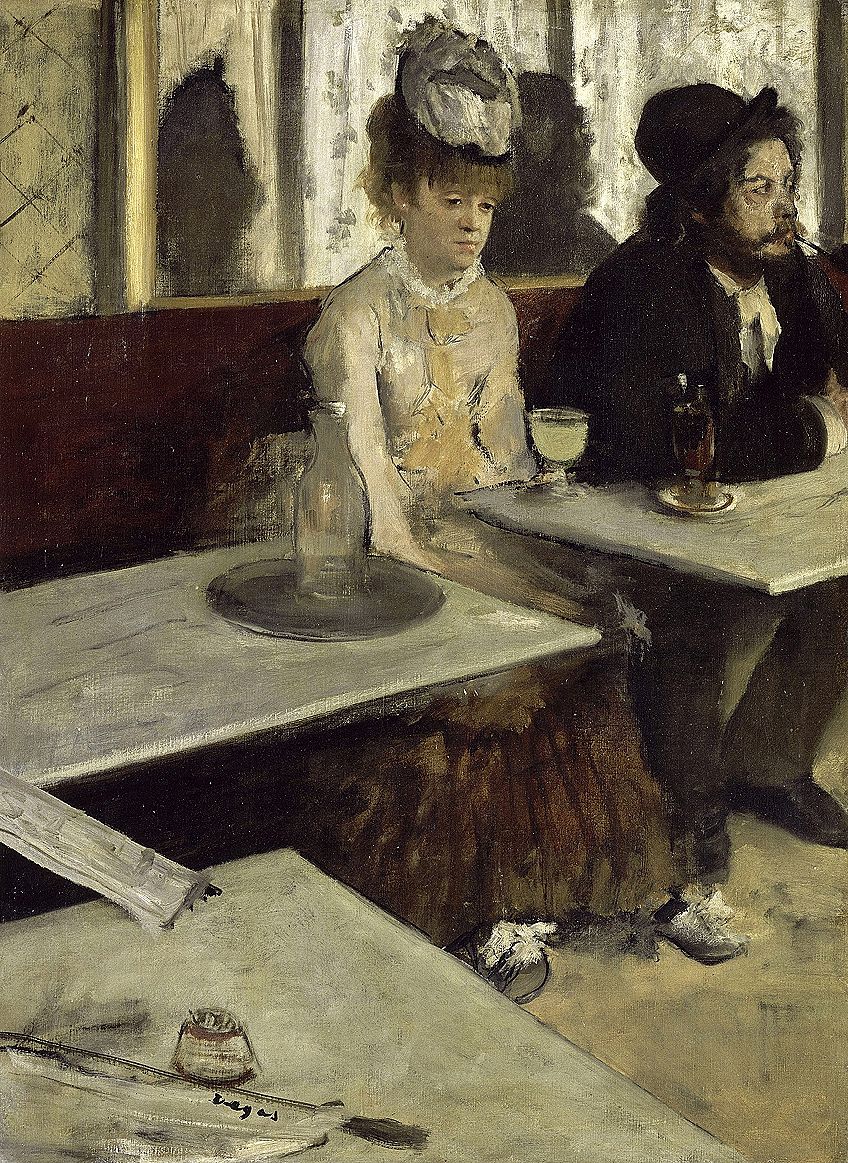
Racetrack settings enabled him to represent horses and jockeys in a contemporary setting. He started to portray women working, such as laundresses and milliners. Degas’ dancers were another common element of these paintings of women at work. Degas’ ballerina paintings were increasingly produced from 1870 onwards, as they always sold well, which helped in raising the money needed to take care of the debts that his brother had accumulated. In the mid-1870s, he started to focus on scenes of Parisian nightlife, such as L’Absinthe (1876). As his subject matter diversified, so did his techniques: the somber palette influenced by Dutch art gave way to the use of vibrant colors and powerful brushstrokes.
Edgar Degas’ paintings like Place de la Concorde (1875) seem like snapshots of time – preserving periods of time to accurately reflect them and generating an impression of movement.
The lack of color in many of his ballet paintings was said to be attributed to his emerging fascination with the new photographic technology. His art was influenced by both modern photography and the Impressionist movement, with its impulsive imagery and unusual viewpoints, as demonstrated by the adjustments to his color scheme, brushstroke technique, and sense of arrangement.
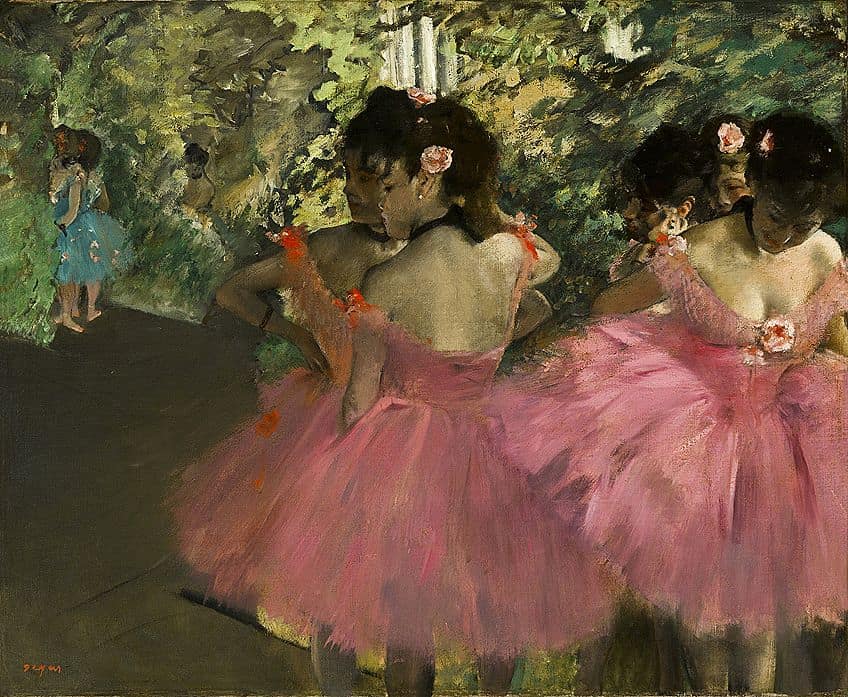
Even in works that are generally finely executed, Degas’ mature technique is defined by noticeably unfinished sections. He often blamed his failure to complete his works on eye problems, an excuse that drew criticism from peers and collectors who argued that his paintings could not have been created by anybody with poor eyesight. Additionally, he was infamous for starting projects and never considering them complete, or abandoning them towards the end – potentially more realistic reasons for the unfinished sections than any of the reasons he had offered.
Degas’s interest in portraiture led him to thoroughly examine how a person’s social status or occupation might be indicated by their posture, physiognomy, clothing, and other qualities.
Degas would take a sketchbook with him when he went to countless trials, and his various depictions of the defendants demonstrate his fascination with the atavistic traits that some 19th-century scientists believed to be proof of inherent immorality and criminality. When he depicted laundresses and dancers in his works, he indicated their professions not just through their clothing and actions but also through their physical characteristics: his laundresses are hefty and sturdy, while his ballerinas have an athletic physicality.
Edgar Degas’ Sculptures
The Little Dancer of Fourteen Years, Degas’s lone sculpture display during his lifetime, debuted in 1881. An almost life-size wax statue with actual hair and a fabric tutu, it generated a significant response from critics, the majority of whom considered the dancer to be unattractive while finding the realism remarkable. One observer remarked that all viewers’ preconceptions about sculpture, of those cool emotionless whitenesses, were now shattered by the devastating realism of the sculpture. He believed that Degas had transformed sculpture’s traditions with his first try, just as he had long before overturned painting’s standards.
Degas produced several more sculptures over the course of 40 years, but they were not viewed by the public until a posthumous showcase in 1918.
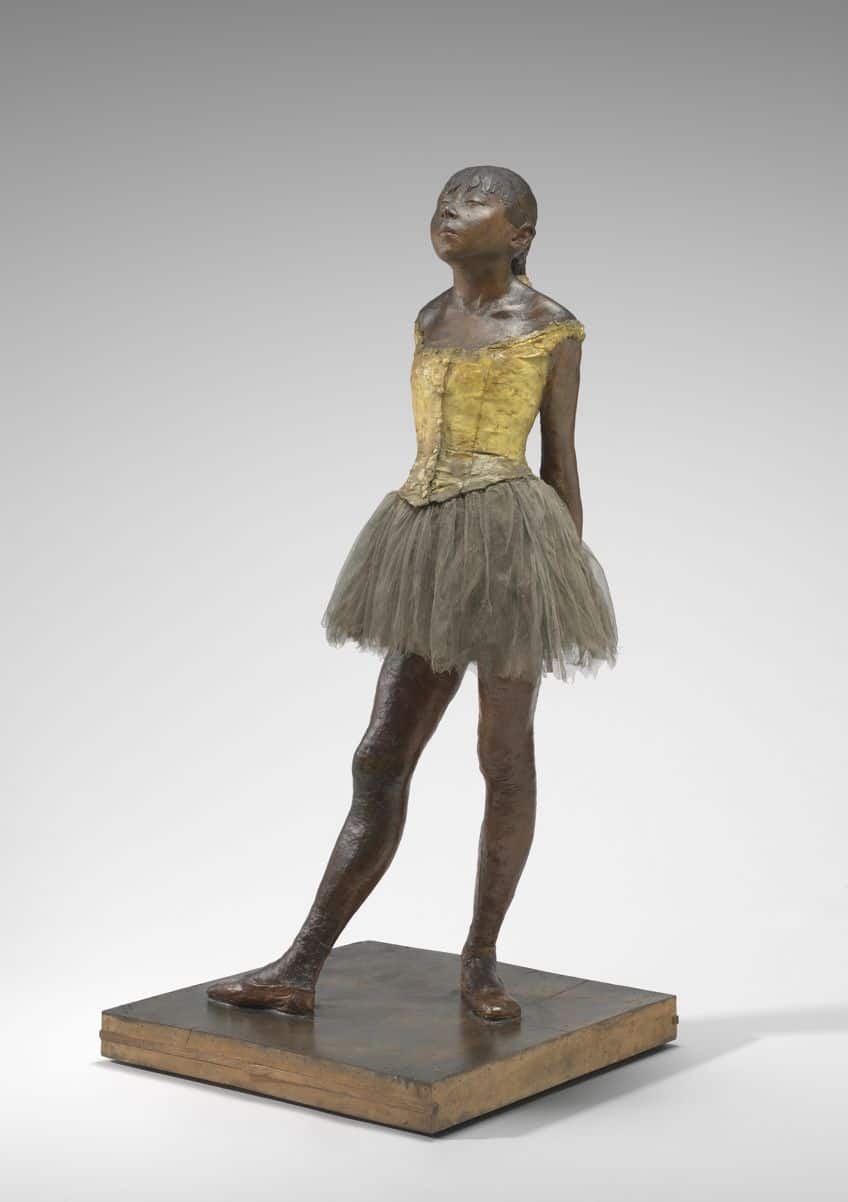
During his lifetime, none of Degas’ sculptures were cast in bronze. Although Degas routinely explored techniques to connect graphic art with oil painting, drawing with pastels and sculpture with photography, academics have concluded that the sculptures were not made as references for his paintings. Following Degas’s death, his heirs discovered 150 wax works in his workshop, many of which were deteriorating. They consulted Adrien Hébrard, the owner of a foundry, who determined that 74 of the wax statues could still be cast in bronze.
Edgar Degas’ Legacy and Reputation
During his lifetime, Degas the artist produced works that were met with both public contempt and admiration. His art was polarizing, although it was widely acclaimed for its draftsmanship. Although he did not personally like or associate with the term, he is often regarded as one of the Impressionist movement’s founders. Despite the fact that he had no official pupils, he had a significant impact on many famous artists, most significantly Mary Cassatt, Jean-Louis Forain, and Walter Sickert; his biggest admirer, however, was said to be Henri de Toulouse-Lautrec.
Degas’ sculptures, paintings, pastels, and sketches can be found in numerous institutions and have been the focus of multiple museum exhibits and retrospectives.
Degas led an outwardly inconspicuous lifestyle because he felt that an artist should live alone and that his private affairs must remain hidden. In company, he was noted for his sharp wit, which could be cruel at times. Despite the criticism Degas faced while he was alive, at the time of his passing, he had solidified his standing as one of the leading figures in French art of the late 19th century. It had also become apparent how different he was from the Impressionists and how oriented he was toward Realism, which eventually came to be admired and appreciated by other artists and the public.
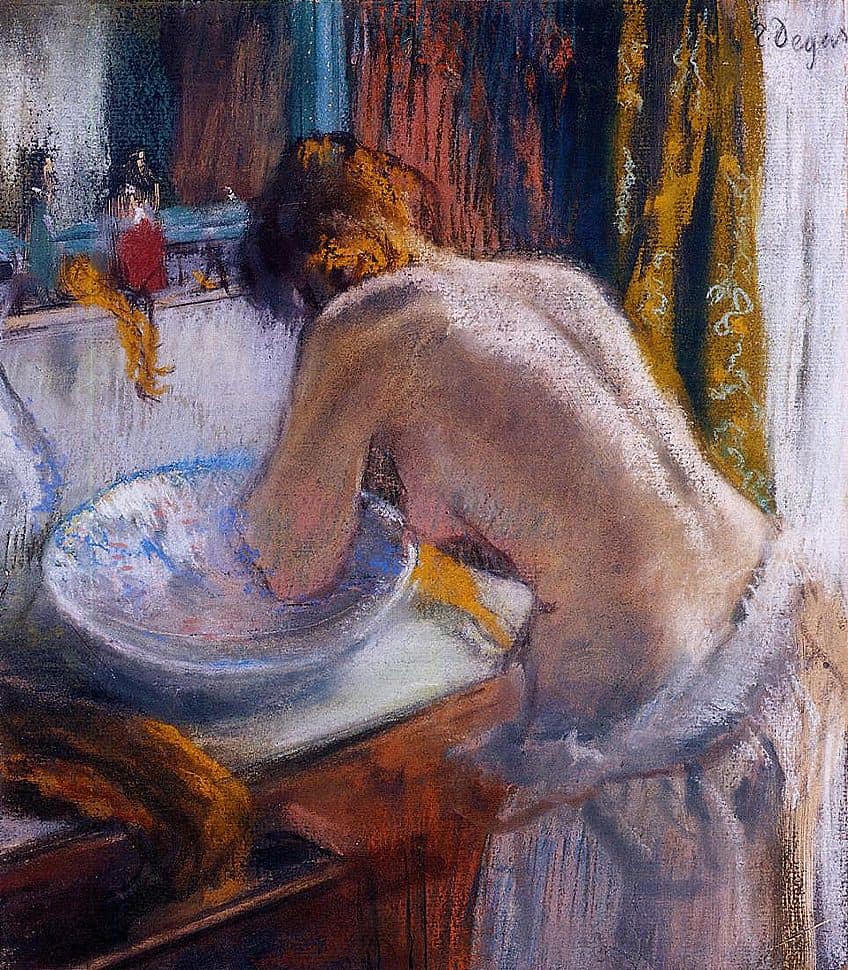
His reputation has only grown after his passing, despite the fact that since the 1970s he has received significant academic attention and condemnation, mostly due to his misogynistic depictions of women. Some people have even connected his attitude towards women to his antisemitism and fundamental lack of morality. However, Degas’ approach to painting his feminine figures appears to fall into an exceptionally intriguing and puzzling paradox. While there are many indications that he was a sexist, there is also a substantial indication that he was so charmed by the female form that he made countless painstaking studies in an attempt to portray it in its purest form. Regardless of what the actual truth may be, his output enriched the appreciation and study of form and portraiture.
Notable Edgar Degas Paintings
Degas’ academic education instilled a strong classical inclination in his artwork, which was in contrast to the Impressionists’ approach. They valued color and placed a larger emphasis on surface textures, while he favored line as a way to define contours and provide an image with a strong compositional structure. While they mainly preferred painting outside, Degas chose to paint from sketches and memory in a classic academic manner. Here are a few renowned examples of Edgar Degas’ paintings.
| Artwork | Date | Medium | Dimensions (cm) | Location |
| The Bellelli Family | 1867 | Oil on canvas | 200 x 253 | Musée d’Orsay, Paris, France |
| Monsieur and Madame Édouard Manet | 1869 | Oil on canvas | 65 x 71 | Kitakyushu Municipal Museum of Art, Kitakyushu, Japan |
| Foyer de la Danse | 1872 | Oil on canvas | 33 x 46 | Musée du Louvre, Paris, France |
| A Cotton Office in New Orleans | 1873 | Oil on canvas | 73 x 92 | Musée des Beaux-Arts de Nice, France |
| La Toilette | 1886 | Pastel on paper | 74 x 60 | Pushkin Museum, Moscow, Russia |
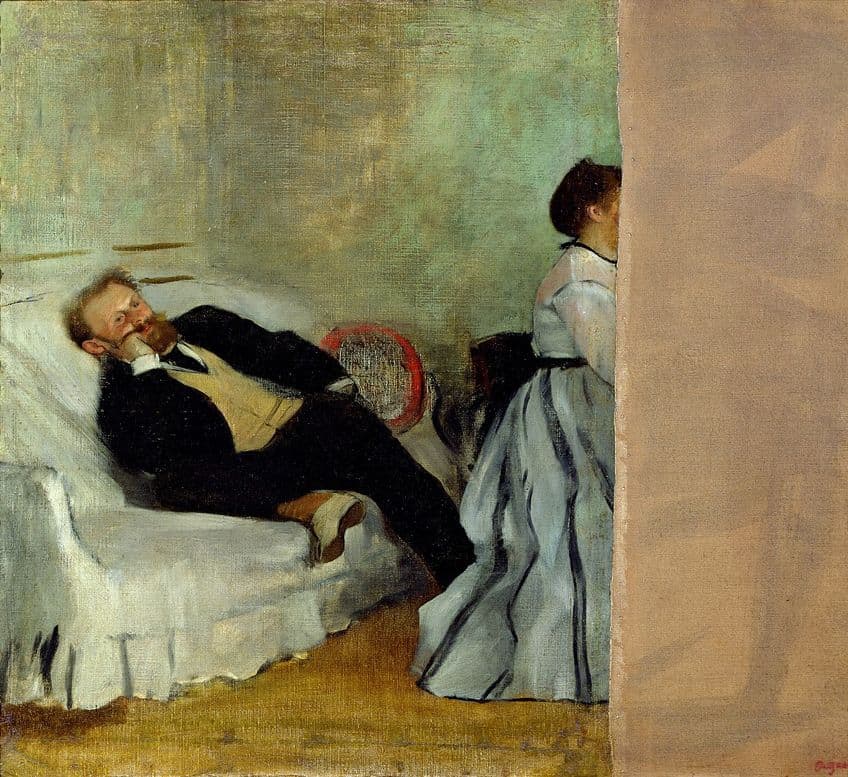
With that, we have come to the end of our introduction to Edgar Degas’ biography and artwork. Degas the artist was not just a respected painter, but also produced sculptures and drawings. Degas’ dancers were a particularly renowned aspect of his oeuvre. Despite the renown of his works, he was known to be a very reclusive individual, typically characterized as demanding and difficult. He was also known to be very critical of the works of others. However, he was also regarded as an extremely passionate and dedicated person, who put his art above everything else in his life.
Take a look at our Edgar Degas paintings webstory here!
Frequently Asked Questions
Was Edgar Degas the Artist an Impressionist?
For the artist, this was quite a contentious subject. Although he worked closely with many of the Impressionists, and was indeed considered to be one of the movement’s founders by many people, he personally did not like the association at all. In fact, he was known to regularly deride their practice of painting outdoors, preferring to work from sketches in his studio. He actually thought of himself as more of a Realist.
Were Edgar Degas’ Sculptures Popular?
Edgar Degas the artist was more known for his paintings, however, he did produce many wax sculptures, of which 150 were found by his relatives after his death. None of them had been cast in bronze in his lifetime, however, 75 of those found were analyzed and deemed suitable for the process. The only one to ever be displayed at an exhibition, The Little Dancer of Fourteen Years (1881), received mixed reviews upon its presentation. Some people lauded the life-like stance, while others found the figure unattractive.
What Was Edgar Degas’ Most Prominent Subject Matter?
Degas’ ballerinas were a regular subject of his works. He also liked to depict racehorses and jockeys. Another one of his favorite genres was portraiture. His scenes were often likened to photographs – snapshots of certain moments in time, captured forever on canvas. It is said that the muted colors in Degas’ dancers’ paintings were also influenced by the color palette typically found in photographs from that era. Whatever the topic, the most notable feature of his works was the contemporary subject matter rendered in a classical style.
Jordan Anthony is a Cape Town-based film photographer, curator, and arts writer. She holds a Bachelor of Art in Fine Arts from the University of the Witwatersrand, Johannesburg, where she explored themes like healing, identity, dreams, and intuitive creation in her Contemporary art practice. Jordan has collaborated with various local art institutions, including the KZNSA Gallery in Durban, the Turbine Art Fair, and the Wits Art Museum. Her photography focuses on abstract color manipulations, portraiture, candid shots, and urban landscapes. She’s intrigued by philosophy, memory, and esotericism, drawing inspiration from Surrealism, Fluxus, and ancient civilizations, as well as childhood influences and found objects. Jordan is working for artfilemagazine since 2022 and writes blog posts about art history and photography.
Learn more about Jordan Anthony and about us.
Cite this Article
Jordan, Anthony, “Edgar Degas – The Impressionist Works of Degas.” artfilemagazine – Your Online Art Source. April 11, 2023. URL: https://artfilemagazine.com/edgar-degas/
Anthony, J. (2023, 11 April). Edgar Degas – The Impressionist Works of Degas. artfilemagazine – Your Online Art Source. https://artfilemagazine.com/edgar-degas/
Anthony, Jordan. “Edgar Degas – The Impressionist Works of Degas.” artfilemagazine – Your Online Art Source, April 11, 2023. https://artfilemagazine.com/edgar-degas/.



